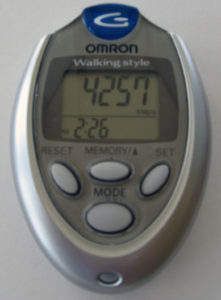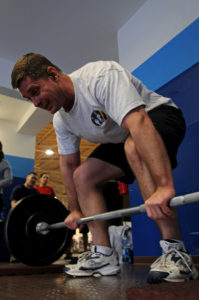“Gotta get my steps in today.”
“I didn’t exercise, but at least I got my steps.”
“How many steps are you at today?”
Chances are that you or someone you know is seemingly obsessed with their step count.
To me, it’s as if they didn’t achieve 10,000 steps, they would be struck down by the god of walking.
In other cases, I’ve heard people use walking as an excuse. Maybe they didn’t get their planned workout in, but, by golly, they hit their steps, so that’s good enough.
I enjoy walking, and I know others do, too. For as long as I’ve been alive, my mom has made it a point to walk most days of the week. My former boss is a restless man who would seize any opportunity he had to take a walk for a meeting instead of sit in a stuffy conference room. And I’ve had a number of clients who swear by their walking.
The point of this post is not to argue the merits of walking. Those are well established, and, as we’ll see, beneficial in countless ways.
The point of this post is to help us understand whether walking counts as a workout. Do we just chase 10,000 steps a day? Do we need to be doing something else in addition?
Let’s take a look at what happens if we do nothing, and what happens when we get moving.
What Happens If We Just Sit On Our Butts?
Yeah, sometimes I think the people who freak out over steps are kinda nuts, but at least they’re making an effort.
Let’s talk about the people on the opposite end of the spectrum.
“The obesity epidemic is attributed in part to reduced physical activity,” say researchers published in the American Journal of Epidemiology. “Evidence supports that reducing time spent sitting, regardless of activity, may improve the metabolic consequences of obesity.”
They found that time spent sitting was associated with a higher risk of mortality in both men and women.
Another study published in the International Journal of Obesity found similar outcomes. Researchers in 2017 looked at the health effects of healthy, non-smoking Glasgow postal workers. The study found that workers who took fewer steps and spent a longer time sitting faced more cardiovascular risks than those who took more than 15,000 steps per day and spent more than seven hours upright. In brief, they found that “longer time spent in sedentary posture is significantly associated with higher [coronary heart disease] risk and larger waist circumference.”
However, even people who are active aren’t immune to the effects of sitting.
In 2012, researchers found that adults who reported more than seven hours of moderate to vigorous physical activity per week and who watched more than seven hours of TV a day still had a higher risk of mortality than those who reported less than an hour a day of watching TV. (I’ll have more about this later on.)
These studies shine a light on how sedentary behavior for anyone, regardless of their activity levels, can be harmful.
Why Is 10,000 The Magical Number Of Steps?
Now, we know sedentary behavior is linked to potentially dangerous effects.
But, how do we go from zero activity to having to walk 10,000 steps a day?
For the answer, we have to look at the 1964 Olympics.
Prior to the Tokyo Games, a company released a pedometer called the “man-po-kei,” which is said to translate into “gauge of 10,000 steps.”
“It was a business slogan,” Catrine Tudor-Locke (who will be more prominently featured later) told the BBC, “like ‘Just Do It’ for Nike, but it resonated with people.”
Since then, both Japan and the United Kingdom have recommended that people walk up to 10,000 steps a day.
“In the academic space, we’ve known for a long time that the response you have to exercise is very specific,” Dr. Ben Kelly says.
Kelly cites a study by his organization that says “5-10 percent of the population showed no measurable improvement after following” the guideline to walk 10,000 steps a day.
Dr. Greg Hager, also interviewed in the same Telegraph article, said “many of today’s fitness apps and devices had no basis in evidence and that a one-size-fits-all approach could be harmful. He singled out the way some devices encourage users to clock up 10,000 steps a day – calling it an arbitrary number made up in a 1960s Japanese study.”
Reading these articles formed the rationale behind writing this article.
Sure, 10,000 is an admirable number (I used to use a Fitbit, so I know how challenging it can be to walk 10,000 steps a day). But, is this number effective for people to lose weight? Or is it just a memorable marketing ploy by companies that sell wearable fitness trackers?
Pedometers Offer Some Benefits
How do we even track the amount of steps we take, anyway?
A pedometer is a wearable technology that helps people understand how many steps they’ve taken. They can be standalone devices or included in things like your smartphone or smart watch.
The use of a pedometer in addition to a “standard behavioral intervention” was linked in one study to weight loss in young adults with a BMI between 25 and 40, which are numbers that classify a person as obese or overweight.
However, the study also found that “devices that monitor and provide feedback on physical activity may not offer an advantage over standard behavioral weight loss approaches.”
In other words, they found no difference between whether to use a pedometer after having intervened with someone.
Other studies were more positive.
In 2012, researchers found the potential for pedometers to be effective in the short term.
And, in 2007, another group of researchers found that a “technology-based program needs to be used continuously throughout the intervention period to significantly impact weight loss.”
All of these studies suggested future research to study whether using wearable technologies is effective for long-term weight loss.
What Benefits Does Walking Have?
Regardless of whether you wear a pedometer, walking has countless benefits. From the U.S. Surgeon General:
- Walking requires no special skills, facilities, or expensive equipment.
- Walking is an easy physical activity to begin and maintain as part of a physically active lifestyle
- “Most people are able to walk, and many people with disabilities are able to walk or move with assistive devices, such as wheelchairs or walkers.”
- “Walking has a lower risk of injury than vigorous-intensity activities.”
- “Walking also may be a good way to help people who are inactive become physically active because walking can be easily adapted to fit one’s time, needs, and abilities.”
- “People walk for many purposes, such as for transportation to get to school, work, a store, or the library or for leisure to have fun, socialize with friends or family, walk their dog, or improve their health. Because walking is multipurpose, it provides many opportunities for people to incorporate physical activity into their busy lives.”
Physiologically, walking interrupts “sitting time with short bouts of light- or moderate-intensity walking lowers postprandial glucose and insulin levels in overweight/obese adults,” according to a 2012 study. “This may improve glucose metabolism and potentially be an important public health and clinical intervention strategy for reducing cardiovascular risk.”
Earlier, I questioned whether walking 10,000 steps a day was beneficial or whether it was just a marketing gimmick.
One study also spawned from my skepticism. Researchers developed a 15-week program in which people accumulated 10,000 steps per day to see whether it demonstrated any benefits. Results from the study suggested that doing so “improves cardiovascular performance and personal growth and also positively influences many variables that are indicators of health, fitness and psychological well-being.”
From that perspective, I’ll buy it. The program suggests that walking will indeed provide health benefits.
But, I still wasn’t sold on whether walking constituted its own workout, or whether just walking 10,000 steps a day was sufficient for most people.
That’s when I turned to the Centers for Disease Control and Prevention.
CDC guidelines state:
“The Physical Activity Guidelines for Americans recommend that adults get at least 150 minutes of moderate-intensity aerobic physical activity or 75 minutes of vigorous-intensity physical activity, or an equivalent combination each week.”
What Is Moderate To Vigorous Physical Activity?
As you’ll soon see, the term “moderate to vigorous physical activity” popped up over and over again. So much so that the term got its own acronym: MVPA.
To understand the concept of MVPA, we must first understand another acronym: the MET.
A metabolic equivalent (MET) is how exercise experts measure activity. When you sit quietly, that’s one MET.
Harvard says that average adults burn one calorie per hour for every 2.2 pounds of body weight—”someone who weighs 160 pounds would burn approximately 70 calories an hour while sitting or sleeping.”
Moderate activities are those gauged between 3-6 METs.
The CDC provides some examples of activities in this range, such as walking 3-4.5 miles per hour, using crutches, hiking, or roller skating. People exercising at this pace, according to the American Heart Association, can generally hold a conversation.
Activities more than 6 METs are considered vigorous, and those would be activities such as mountain climbing, water jogging, martial arts, boxing, and even clogging. People exercising at this intensity probably find it difficult to carry on a conversation or even saying more than a few words.
The problem with METs is that they can be hard to measure. That’s why personal trainers use a more useful intensity gauge, the Rating of Perceived Exertion (RPE).
“Perceived exertion is how hard you feel like your body is working,” says the CDC. “It is based on the physical sensations a person experiences during physical activity, including increased heart rate, increased respiration or breathing rate, increased sweating, and muscle fatigue. Although this is a subjective measure, a person’s exertion rating may provide a fairly good estimate of the actual heart rate during physical activity.”
What’s nice about the RPE rating, says the CDC, is that a “high correlation exists between a person’s exertion rating” multiplied by 10 and the person’s actual heart rate, “so a person’s exertion rating may provide a fairly good estimate of the actual heart rate during activity.”
The RPE scale is based on a 6-20 rating. Moderate activities would probably measure in the 11-14 range, while vigorous activities would probably lean more toward the 17-20 range.
Does Walking Count Toward Moderate To Vigorous Physical Activity?
Part of my skepticism about walking 10,000 steps every day was whether it achieved the threshold for moderate to vigorous activity.
As a weightlifter, CrossFitter, and yoga instructor, my bias going into this article was that I would find that walking 10,000 steps a day wasn’t enough to yield benefits similar to attending a group fitness class or lifting on your own, for example.
One of the core researchers I found was Dr. Catrine Tudor-Locke, the literal walking authority who I quoted earlier regarding the origins of the number 10,000 for step recommendations.
Dr. Locke (who I really hope actually goes by the name Doc Locke) specializes in, among other things, walking, personal monitoring, and step counting.
What I found most interesting from Dr. Locke is that walking 10,000 steps a day is apparently a valid exercise strategy, but it has some qualifications.
First, she brings up the previously mentioned public health guidelines, which, in different terms, recommend at least 30 minutes of moderate-intensity physical activity five days a week. Dr. Locke equates this amount to 3,000-4,000 steps, but they only classify as moderate activity if the steps are:
- Taken at a pace of at least 100 steps/minute,
- Accumulated in at least 10-minute bouts
- “Taken over and above some minimum level of physical activity below which individuals might be classified as sedentary.”
She mentions in later research that “brisk walking should be emphasized with the promotion of any step-based recommendation, in line with public health guidelines’ focus on time in MVPA. The additional benefits of engaging in even more vigorous intensity activities, and activities that do not necessarily focus exclusively on bipedal locomotion, should also be acknowledged.”
Dr. Locke’s key line, I think, comes in this report: “steps should be taken over and above those taken in the course of habitual and incidental daily activities, and also should be taken in bouts of at least 10-minutes in duration.” [emphasis mine]
In other words, it seems as though these bouts of walking should be accumulated through a focused effort and not just because you had lots of errands to run that day.
Who Shouldn’t Be Walking 10,000 Steps A Day?
As we’ve seen, it is valuable to accrue 10,000 steps in a day.
But that’s just not feasible for everyone.
Walking 10,000 daily steps for older adults and those with chronic diseases may not be sustainable, Dr. Locke concludes. Additionally, she says the number is “problem too low for children” in fighting off obesity.
Childhood obesity, in particular, is more prevalent than ever.
“Despite previous reports that obesity in children and adolescents has remained stable or decreased in recent years, we found no evidence of a decline in obesity prevalence at any age,” wrote researchers in a journal published in the American Academy of Pediatrics. “In contrast, we report a significant increase in severe obesity among children aged 2 to 5 years since the 2013–2014 cycle, a trend that continued upward for many subgroups.”
Can You Lose Weight Just By Walking?
Yes.
Theoretically, you can lose weight and still be inactive. That’s because you could drop the amount of calories you’re taking in.
One pound of bodyweight is approximately 3,500 calories. By cutting 500 calories per day from your diet, you could drop 1 pound a week (7 days x 500 calories = 3,500).
InBody has called out Fitbit for claiming that people who walk 10,000 steps a day can burn 3,500 calories from walking. The body composition analysis firm argues that how many calories you burn from walking depends on three things:
- how much you weigh,
- how fast you walk, and
- how far you walk.
They provide an example:
“For a 160-pound person, a leisurely 30-minute walk at 2 mph yields a burn of 102 calories, but walk at a more upbeat pace (3.5 mph) and the calorie burn increases by 54 percent to 157 calories.”
Even if weight loss isn’t your goal, low-intensity movement has a variety of benefits to combatting sedentary behavior.
“If a person is capable and willing to get up and move once per hour, five minutes of 2-MET movements is sufficient to drive pretty dramatic swings in HDL, triglycerides and blood glucose,” write researchers for the American Council on Exercise. “If getting up every two hours is more manageable, then the duration of the movement bout extends to 10 minutes, though the MET level stays the same.”
2-MET movements include standing, folding laundry, talking on the phone, washing dishes, and eating.
One note that the researchers and I found striking is that they found a “sustained exercise program may not be enough to improve cardiometabolic health if the individual is otherwise sedentary.”
In other words, if you sit at a desk all day and work out for an hour afterwards, you may need to do more to improve your health. This echoes the findings I cited earlier in this post—even if you exercise for an hour a day but are otherwise sedentary, you still could face health risks.
What’s The Bottom Line?
My goal was to find out whether walking 10,000 steps a day was indeed valid exercise.
After looking at all of this information, that seems to be the case. However, keep in mind that, as mentioned, your steps need to be focused over a certain duration and intensity to lose weight, and they should probably be a supplement to whatever workout routine you’re doing.
Many people—and, in my experience, most people—like to walk.
But, it may not be for you. Nerd Fitness perfectly sums up advice on exercise: “Do what you love. And don’t do what you don’t like.”
Photo by Arek Adeoye on Unsplash




